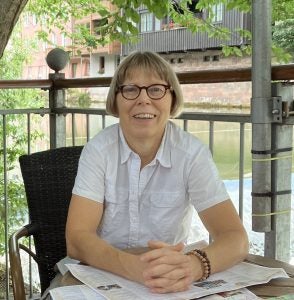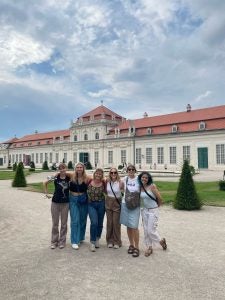I grew up in the small German town of Bad Schwalbach. This idyllic town of eight-thousand inhabitants is nestled in the Taunus Mountains near the wine-growing region along the Rhine. Perhaps this is where I got my love of history: I spent a lot of time climbing around the ruins of medieval fortresses along the banks of the Rhine. When I was seventeen, my family moved to New York. This was the perfect age to move from a small town to the big city. After the fascinating anthropological experience of attending an American high school for six months, I started my university education at Hofstra University on Long Island, where I studied History and French. I wanted to become fluent in French, so I spent my junior year abroad on the French Riviera studying at the Université de Nice. My year in France was a fantastic experience—so I always urge students not to miss out on the opportunity to study abroad. —— After graduating from Hofstra, I started graduate school in history at Yale University. I studied early modern German history and spent three years doing research
Schwalbach. This idyllic town of eight-thousand inhabitants is nestled in the Taunus Mountains near the wine-growing region along the Rhine. Perhaps this is where I got my love of history: I spent a lot of time climbing around the ruins of medieval fortresses along the banks of the Rhine. When I was seventeen, my family moved to New York. This was the perfect age to move from a small town to the big city. After the fascinating anthropological experience of attending an American high school for six months, I started my university education at Hofstra University on Long Island, where I studied History and French. I wanted to become fluent in French, so I spent my junior year abroad on the French Riviera studying at the Université de Nice. My year in France was a fantastic experience—so I always urge students not to miss out on the opportunity to study abroad. —— After graduating from Hofstra, I started graduate school in history at Yale University. I studied early modern German history and spent three years doing research in archives and libraries in Munich and Augsburg in Bavaria. This is when I began exploring Austria, hiking and mountain climbing in the Austrian Alps. I started teaching at UC Davis in 1992. After publishing my first book, Defiled Trades, about outcast professions (most notably executioners) in early modern Germany, I continue to do research on crime. My most recent book, Suicide by Proxy in Early Modern Germany, is about homicide and blasphemy in eighteenth-century Germany, a project which has taken me to Austrian archives in Vienna, Salzburg, and Linz. Three chapters on early modern Vienna are particularly relevant to students in this program. To hear about a particularly tragic Austrian murder case featured in the book, you can listen to my interview with Ira Glass on “This American Life.” I served as historical advisor to the feature film, The Devil’s Bath (2024), by Austrian filmmakers Severin Fiala and Veronika Franz, inspired by this particular murder case.
in archives and libraries in Munich and Augsburg in Bavaria. This is when I began exploring Austria, hiking and mountain climbing in the Austrian Alps. I started teaching at UC Davis in 1992. After publishing my first book, Defiled Trades, about outcast professions (most notably executioners) in early modern Germany, I continue to do research on crime. My most recent book, Suicide by Proxy in Early Modern Germany, is about homicide and blasphemy in eighteenth-century Germany, a project which has taken me to Austrian archives in Vienna, Salzburg, and Linz. Three chapters on early modern Vienna are particularly relevant to students in this program. To hear about a particularly tragic Austrian murder case featured in the book, you can listen to my interview with Ira Glass on “This American Life.” I served as historical advisor to the feature film, The Devil’s Bath (2024), by Austrian filmmakers Severin Fiala and Veronika Franz, inspired by this particular murder case.
About Teaching Abroad
One of my favorite things about this Summer Abroad Program is teaching history “on location”; when we learn about the plague, we visit the catacombs of St. Strephen’s Cathedral where hundreds of skeletons of the plague’s last victims are laid out. We learn about the Baroque by walking through the ballrooms of Schönbrunn Palace. And finally, I love introducing students to exotic foods—Blunzengröstl anyone? Or is Kaiserschmarrn (“Imperial Nonsense”) more to your liking?
Email me at kestuart@ucdavis.edu with any questions!